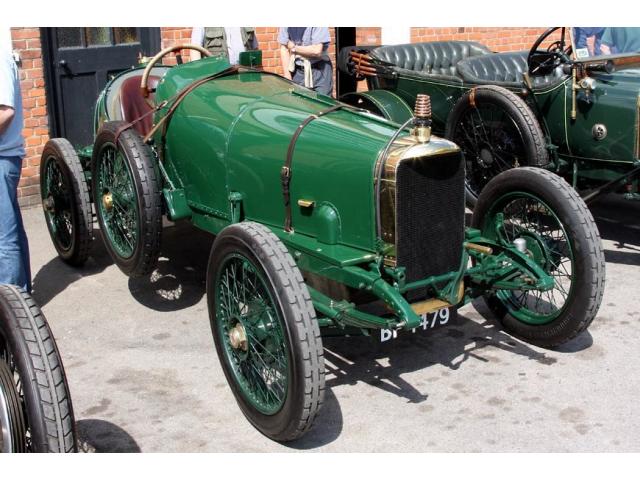1912 Sunbeam Coupe de l’Auto Replica
- Brand: Sunbeam
1912 Sunbeam Coupe de l’Auto Replica
The emphatic victory of Sunbeam's 3-litre cars in the 1912 Coupe de l'Auto and their success in the French Grand Prix against larger-engined competition is one of the great stories of early motor racing.
France's early domination of Grand Prix races was interrupted in 1908 when victory went to a German Mercedes. Interest then shifted to light car and voiturette racing, encouraged by support from the French magazine 'L'Auto', and the 'Coupe de l'Auto' became the main international sporting competition for cars up to 3 litres. By 1911 these races had become less extreme in nature and a number of British manufacturers including Sunbeam decided to enter the fray.
Sunbeam's interest was encouraged by talented French engineer Louis Coatalen, who had joined the company in 1909. His 12hp cars had been successful in domestic competitions and Coatalen persuaded Sunbeam to enter the 1911 Boulogne race, for which he designed a new 3-litre engine. The latter was fitted in an almost standard 12hp chassis bodied for long-distance competition, which used standard Sunbeam peg-drive wire wheels, a design Coatalen had brought with him from Humber. The car was fitted with a unique, tall, streamlined body and ran well until the 8th lap when it struck a kerb when overtaking and failed to finish. When running, the Sunbeam was said to be 'the fastest car on the course'.
By early 1912, Coatalen was a Sunbeam director and he obtained increased company support for racing. The 47-mile road circuit around Dieppe was announced as the location for the Coupe de l'Auto race and it was decided to run it simultaneously with the revived Grand Prix. Sunbeam entered four cars and spent weeks preparing them at the circuit. The 1911 engine design was reused with some modifications and the five cars built - a team of four plus a spare - all incorporated modified parts from Sunbeam production models.
The racing cars were of streamlined shape in line with the latest thinking, featuring no mudguards and the distinctive exhaust dictated by race rules. Coatalen produced an efficient car capable of sustained high-speed running rather than one capable of powerful bursts of acceleration. His preparation was meticulous, with gear and axle ratios optimised for the long straights that make up the triangular road circuit, while at the same time giving the car the flexibility needed on climbs and fast bends. He also relocated the twin spare wheels to optimise balance with the 32-gallon fuel load.
The Sunbeam engine was a 2,966cc four-cylinder sidevalve with 'L' head. It was désaxé with cylinders cast monobloc and incorporating inclined valves. For the race, slightly larger valves and lightened con-rods and pistons were used. Coatalen also chose the latest large Claudel Hobson carburettor. Fuel was fed from the huge tail tank under air pressure, pumped by the mechanic. Standard lubrication was retained, with a scuttle mounted oil reserve that the mechanic could use to top up the engine during the race.
The transmission consisted of a lightened flywheel and a four-speed gearbox, which was standard except for changed ratios. In order to reduce the car's width the standard chassis and rear axle were narrowed. The wheelbase was shortened to 8' 11" (2.718m) and the rear of the chassis converted from three-quarter elliptic springs to a semi-elliptic design, all of which helped keep the car's weight to no more than 950kgs (2,090lbs).
Coatalen was meticulous in his preparation of the cars and wanted to recruit drivers equally ready for participation in a Grand Prix. He chose drivers familiar with long distance road events: Victor Rigal (Sunbeam's agent in France), Gustave Caillois, Dario Resta and Emile Medinger. As well as practising in the cars on the circuit, the team was the first to practise pit stops using specially prepared quick fill canisters, pumped fuel, and wheels capable of rapid changes with single wheel nuts and quick-acting jacks.
Such meticulous preparation paid off. The Sunbeams ran without serious incident and against a strong opposition finished 1st, 2nd and 3rd in the Coupe de l'Auto and 3rd, 4th and 5th in the French Grand Prix itself. They were beaten only by Boillot's Peugeot and Wagner's FIAT, cars with engines 2½ and nearly 5 times the capacity respectively of the Sunbeams. Sunbeam's victory was greeted with an enormous response in the British press and enthusiastic celebrations.
After the team's success, one car was converted for successful Brooklands record attempts and the others reappeared in the 1913 Coupe de l'Auto with modified exhausts and new front cowls. Then, after a few years use in competition, they disappeared almost completely. Only one appears to have survived, namely 'XE 9869', the car acquired by Lord Montague of Beaulieu in 1958. . It had been re-bodied possibly because it was the car that had been used for record purposes at Brooklands as a single seater and still has a later appearance.
Although previous replicas of the 1912 cars have been attempted, they have failed faithfully to copy the originals. The reconstruction of 'BF 4479' was started as a project by collector Wolfgang H Gawor, who it is believed acquired the necessary parts from the well-known Sunbeam expert Cecil Bendall. He was allowed access to 'XE 9869' at Beaulieu in order to reproduce unique aspects of the racing cars such as the radiator. This work was later continued using the finest craftsmen and extensive photographic research into the details of the originals, keeping 'BF 4479' as close as possible in appearance to a 1912 team car. Due to wear, neither the chassis nor engine numbers were ascertainable and 'BF 4479' uses a contemporary racing chassis number but does not claim to be that actual car.
Descriptions & pictures by bonhams & flickr
| Specification | |
| Production Start | 1912 |
| Country of origin | Great Britain |
































